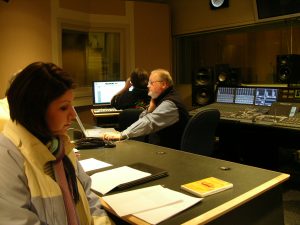Essay by Tonya Carroll
History M.A.
WCU 2009
Starting on the first Tuesday of October and ending the following Saturday, the Cherokee Indian Fair is an annual event one would not want to miss. After over ninety years, this fair has grown to be one of Cherokee’s favorite traditions.
Once the parade has ended, many people rush to the exhibit hall at the fair site to see who has won the competitions for food, clothing, and crafts. Only Eastern Band members are allowed to compete, and every year the competition is tough. Only the best items are entered. First, second, and third places win prize money, ribbons, and most important— bragging rights for a whole year.
Another important part of the fair is the food. Cherokee families sell traditional Cherokee foods like ramps, bean bread, chestnut bread, and wild greens. Other more typical festival foods also served are: hamburgers, fry bread, roasted corn, pizza, cotton candy, candy apples, and popcorn.
Each day of the fair is filled with events to enjoy as well as carnival rides and games for all ages. Previous events have included corn shucking contests, music entertainment, youth and teen pageants for Cherokee girls, and blowgun and archery contests. Other events include the exhibition of a Indian stickball game. This game is similar to lacrosse but much rougher with nearly no rules. The Cherokee have played this ancient game for hundreds, possibly thousands of years.
Officially, the Cherokee Fair has been an annual event since 1912; however, the Cherokee have held festivals for much longer. Early reports of a Cherokee festival come from the Travels of William Bartram. Bartram describes an event he witnessed when he was among the Cherokee in the late 1700s, a festival of music and dancing that rehearsed the ball-play dance.
Almost a century later, in 1868, the Eastern Cherokee Council was given permission to set a place and date to hold “a national fair.” From this report it is clear that the Cherokee were planning to hold a fair as early as 1868.
In 1911, some Cherokee men formed two teams to play a game of Indian Ball at the WNC Fair held in Asheville. This opened up more acceptance of the Cherokee culture to outsiders and proved that the Cherokee and their Caucasian neighbors were ready to share celebrations. The construction of passable dirt roads and the Appalachian Railway connecting Cherokee to nearby areas around 1914 created a transportation route for neighbors to come to Cherokee for a festival.
There are accounts from Cherokees that fairs were held in the Big Cove Community on the Cherokee Indian Reservation in 1912, which is probably why the annual Cherokee Fair is considered to be ninety-six years old today. Also in 1912, the United States Commissioner of Indian Affairs, Cato Sells, traveled to Cherokee to with several people regarding the possibility of holding an Indian Fair in Cherokee. The idea was that each of the six townships that made up the Cherokee Indian Reservation would form a club that would then become a Farmer’s Organization.
In 1914, the first Cherokee Fair was held under the authorization of the Commissioner of Indian Affairs. The Big Cove Township voted to have the fair held in Cherokee and to name it The Cherokee Indian Fair. The two townships that worked to hold the first Cherokee Indian Fair were Big Cove and Birdtown. By this time, Birdtown had also created a Farmer’s Organization. At the first official Cherokee Indian Fair there was an exhibit of canned foods and farm and garden produce, a singing contest, a merry-go-round, even an automobile show, and of course Indian Ball games were held. Indian ball seems to be one of the Cherokee Indian Fair’s main events. I mentioned earlier, this game was the reason Bartram described the festival he attended among the Cherokee. Other events, contests, and activities were later added to the fair’s agenda.
Today the Cherokee Indian Fair is a largely anticipated event by many locals and visitors. Some of the events from the first fair have remained, such as the canned foods and garden and produce competitions. The different townships also still have a big role in the fair. Finally, Indian ball games are still one of the main events of the Cherokee Indian Fair today. However, the fair has also changed activities and events to fit into the modern world. More carnival rides are brought in; games and competitions have been added to fit the interests of people today, because time and technology have an impact on peoples’ interests. But the core purpose of the Cherokee Indian Fair remains the same after nearly a century, to bring the communities together to celebrate Cherokee culture and traditions.


